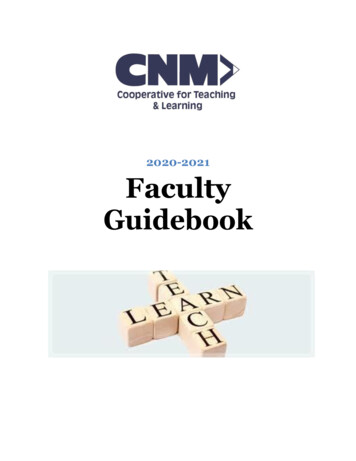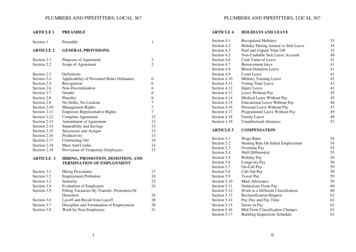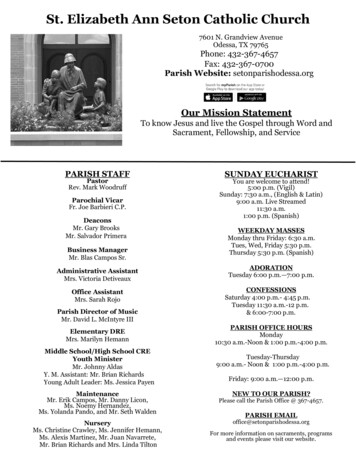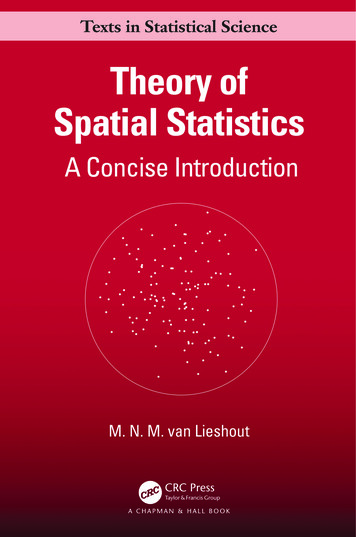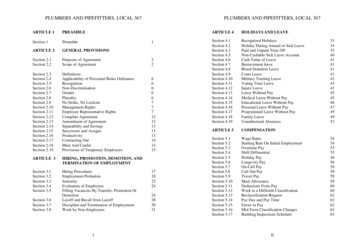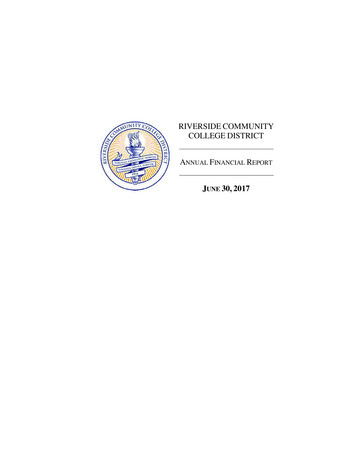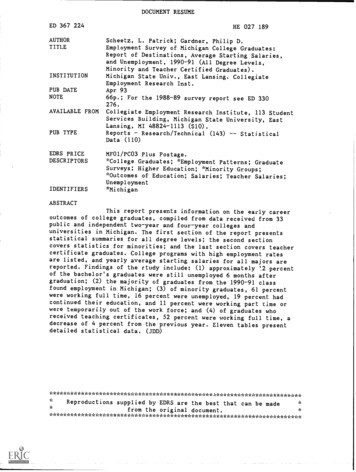
Transcription
DOCUMENT RESUMEED 367 224AUTHORTITLEINSTITUTIONPUB DATENOTEHE 027 189Scheetz, L. Patrick; Gardner, Philip D.Employment Survey of Michigan College Graduates:Report of Destinations, Average Starting Salaries,and Unemployment, 1990-91 (All Degree Levels,Minority and Teacher Certified Graduates).Michigan State Univ., East Lansing. CollegiateEmployment Research Inst.Apr 9366p.; For the 1988-89 survey report see ED 330276.AVAILABLE FROMPUB TYPEEDRS PRICEDESCRIPTORSIDENTIFIERSCollegiate Employment Research Institute, 113 StudentServices Building, Michigan State University, EastLansing, MI 48824-1113 ( 10).ReportsResearch/Technical (143)StatisticalData (110)MF01/PC03 Plus Postage.*College Graduates; *Employment Patterns; GraduateSurveys; Higher Education; *Minority Groups;*Outcomes of Education; Salaries; Teacher Salaries;Unemployment*MichiganABSTRACTThis report presents information on the early careeroutcomes of college graduates, compiled from data received from 33public and independent two-year and four-year colleges anduniversities in Michigan. The first section of the report presentsstatistical summaries for all degree levels; the second sectioncovers statistics for minorities; and the last section covers teachercertificate graduates. College programs with high employment ratesare listed, and yearly average starting salaries for all majors arereported. Findings of the rtudy include: (1) approximately 1.2 percentof the bachelor's graduates were still unemployed 6 months aftergraduation; (2) the majority of graduates from the 1990-91 classfound employment in Michigan; (3) of minority graduates, 61 percentwere working full time, 16 percent were unemployed, 19 percent hadcontinued their education, and 11 percent were working part time orwere temporarily out of the work force; and (4) of graduates whoreceived teaching certificates, 52 percent were working full time, adecrease of 4 percent from the previous year. Eleven tables presentdetailed statistical data. *************************Reproductions supplied by EDRS are the best that can be madefrom the original ******************************
EMPLOYMENT SURVEY OFMICHIGAN COLLEGE GRADUATES:Report of Destinations,Average Starting Salaries, andUnemployment1990-91(All Degree Levels, Minority andTeacher Certified Graduates)L Patrick Scheetz, Ph.D.Director of InstitutePhilip D. Gardner, Ph.D.Research AdministratorApril, 1993Collegiate Employment Research InstituteCareer Development and Placement Services113 Student Services BuildingMichigan State UniversityEast Lansing, MI 48824-1113U.S. DEPARTMENT OF EOUCAT/ONOffice of Educatioosi Research end ImprovementEDUCATIONAL RESOURCES INFORMATIONasCENTER (ERIQdocument has peen reproduced sereceived from the person or organizationPERMISSION 10 REPRODUCE THISMATERIAL HAS BEEN GRANTED EDoriginating0 Minor changes have been made to improvereproduction QualityL. Patrick ScheetzIts of vow, or opnions stated in Due docu-Michigan State Univrn.,it do oaf rIIIKOsiarrty rIggesent MomOERI POeition or poky7 1;TO THE EDUCATIONAL RESOURCESINFORMATIONCENTER (ERICI.2MT COPY MAIM
ACKNOWLEDGMENTSChao-Kang TingData AnalystSvecial thanks for their assistance are extended to personnel at these institutions:Two Year InstitutionsFour Year InstitutionsAlpena Community CollegeAdrian CollegeBaker CollegeAlbion CollegeBay De Noc CollegeCalvin CollegeDelta CollegeCentral Michigan UniversityGlen Oaks Community CollegeDetroit College of BusinessLake Michigan Community CollegeEastern Michigan UniversityLansing Community CollegeFerris State UniversityMonroe Community CollegeGrand Valley State UniversityMontcalm Community CollegeHillsdale CollegeMuskegon Community CollegeLake Superior State UniversityOakland Community CollegeMichigan State UniversityMichigan Technologjcal UniversityNorthern Michigan UniversityOakland UniversitySaginaw Valley State UniversitySpring Arbor CollegeUniversity of Detroit MercyUniversity of Michigan - Ann ArborUniversity of Michigan - DearbornWayne State UniversityCareer Development and Placement ServicesDivision of Student Affairs and ServicesVernicka K. TysonActing DirectorMichigan State UniversityEast Lansing, MI 48824-11I3Copyright: April, 1993MSU is an Affirmative ActionlEqual Opportunity InstitutionPrice: 10.00
TABLE OF CONTENTSPageOverview All Degrees1Minority Graduates7Teacher Graduates9Table 1. Placement Results for 1990-91 Certificate Graduates of SelectedMichigan Colleges and Universities by Curriculum Areas13Table 2. Associate's Degrees Conferred Compared to Graduates Reported andResponding by Participating Institutions for Major Curriculum Areas 1990-91.17Table 3. Placement Results for 1990-91 Associate Degree Graduatesof Selected Michigan Colleges and Universities by Curriculum Areas.Table 4. Bachelor's Degrees Conferred Compared to Graduates Reported andResponding by Participating Institutions for Major Curriculum Areas 1990-9118.26Table 5. Placement Results for 1990-91 Bachelor's Graduates of SelectedMichigan Colleges and Universities by Curriculum AreasTable 6. Master's Degrees Conferred Compared to Graduates Reported andResponding by Participating Institutions for Major Curriculum Areas 1990-91Table 7. Placement Results for 1990-91 Master's Graduates of SelectedMichigan Colleges and Universities by Curriculum AreasTable 8. Doctoral Degrees Conferred Compared to Graduates Reported andResponding by Participating Institutions for Major Curriculum Areas 1990-91.27.3839.48Table 9. Placement Results for 1990-91 Doctoral Graduates of SelectedMichigan Colleges and Universities by Curriculum Areas.49Table 10. Placement Results for 1990-91 Bachelor's Graduates of SelectedMichigan Colleges and Universities by Curriculum Areas for Minorities54Table 11. Placement Results for 1990-91 Bachelor's Graduates of SelectedMichigan Colleges and Universities by Curriculum Areas for Teachers.59
Michigan 1990-91 Report of Destinations presents information on the early career out-comes of college graduates at all degree levels, plus minority and teacher certificatedgraduates. The information in this report has been compiled from data received from 33public and independent two-and four-year colleges and universities in Michigan.Reporting institutions accounted for about the same number of graduates, based upon thetotal degrees conferred by degree level, as last year. However, the number of graduatesproviding information (responding to their institution's follow-up surveys) actually dropped,particularly for bachelor's and master's degree recipients. Thus, early destination informationwas available on fewer graduates (approximately 1,200 bachelor's degree recipients) than in1989-90.Lower response rates (a 10 percent decrease) can be attributed to the poor labor marketthat these graduates faced. The longer time required to find a job resulted in an increasednumber of graduates being unemployed at the time of many institutions' surveys--usually aboutsix months after graduation. Unemployment and uncertainty about future plans are knownto depress response rates. Throughout this report, readers should use caution when interpreting results because of possible sample size restrictions.This report contains three sections. The first section presents the statistical summaries forall degree levels. Compiled statistics for minorities are located in the second section. The lastsection covers teacher certificate graduates.ALL GRADUATESInstitutions supplying data for this report accounted for approximately 26 percent, 63percent, 44 percent, and 41 percent of associate's, bachelor's, master's and doctoral degrees,respectively, conferred in the 1990-91 academic year. As the summary table indicates, thenumber of graduates responding to their institution's follow-up inquires ranged from 18percent at the associate level to 32 percent at the bachelor's. The response rate amongreporting institutions hovered around 50 percent with the exception of the associate's level.TotalDegreesDm rof GradsReportedNA5,70828,0736,2541,643Numberof GradsRuponding6734,04314,2152,8076291ReportedGrads asa % ofConferredRespondingGrads asa % ofConferredRespondingGrads asa % ofReportedNA266344NANA1870504438415321915
Tables 2, 4, 6, and 8 compare data on degrees conferred (information provided by the Stateof Michigan) with aggregated figures from participating institutions. For each degree level,major classification of instructional programs (CIP) or curriculum groups are listed. In a fewcases, State figues exceeded reported numbers. These discrepancies appear to result fromchanges in CIP classifications and accounting problems.Curriculum areas providing the best responses (respondents as a percentage of degreesconferred) include communications technology, engineering, and agriculture at the bachelor'slevel; agriculture, home economics, and liberal studies at the master's level; and communications at the doctoral level.EARLY DESTINATIONSAfter completing their degrees, graduates can either be employed full-time, pursuingfurther education, or seeking employment. These three categories captured the majority ofgraduates as reported in Tables 1, 3, 5, 7, and 9. If the three categories (employed full-time,unemployed, and school) in any row do not total 100 percent, the remaining graduates havebeen placed in an "other" category. The "other" group consists of foreign students who returnedto their home countries, individuals who were unemployed but not seeking work or workingpart-time.Summarizing from the degree level tables, more than 60 percent of all reported graduateswere working full-time. The exception was for associate degree's where a higher percentageof graduates were continuing their education, 32 percent, than the other groups. The percentage of bachelor's graduates continuing their education rose noticeably, an increase of fivepercent from 1989-90.Approximately 12 percent of the bachelor's graduates were still unemployed some sixmonths after graduation; an increase of four percent from 1989-90. Master's graduates whowere unemployed also rose slightly from five percent in 1989-90 to seven percent in 7395651
FULL-TIME EMPLOYMENTThe number of graduates engaged in full-time employment can vary widely within a majorCIP category. Programs with high employment rates (generally greater than 75 percent) havebeen identified. To insure that these programs are representative, only programs with 50 ormore graduates (ten for the Doctoral level) have been included in the following list. It shouldbe noted that many advanced degree recipients were working while they earned their degrees(i.e. teachers) and simply continued their employment after graduation.Full-Time EmploymentCIP with 75 Percent EmployedAssociate's:Management Science, Accounting and Computing, ExecutiveSecretarial, Industrial Technology, Dental Hygiene, Radiograph Medical Technology, and Nursing.Bachelor's:Packaging, Accounting, Banking and Financing, Business Administration, Material Management and Purchasing, Institutional Management, Management Information Systems, Management Science,Marketing Management, Trade and Industrial Management, OfficeSupervision, Sales, Business Marketing, Teleconununication, Computer and Information Sciences, Special Education, Engineering(General), Industrial Production, Automotive Technology, PhysicalTheraphy, Nursing, Pharmacy, Textiles and Clothing (Retail), FineArts Studies, and Parks and Recreation Management.Masters:Business Administration, Labor and Industrial Relations, MBA(Non-Technical), MBA (Technical), Marketing, Advertising, Computer and Information Science, Education (General), Curriculum andInstruction, Elementary and Secondary Education Administration,Special Education, Student Counseling, Elementary Education, PreElementary Education, Health Education, English Second Language,Electrical Engineering, Mechanical Engineering, Nursing, and SocialWork.Doctoral:Education Administration, Higher Education Administration, Electrical Engineering, Mechanical Engineering, Human Medicine, Optometry, Osteopathic Medicine, Veterinary Medicine, Law,Chemistry, Physics, Psychology, and History.3
UNEMPLOYMENTWhen graduates were still seeking employment at the time their institutions administeredtheir surveys, the graduates were classified as unemployed. Depending on the surveystrategies used by participating institutions, this category best reflects those graduates who hadnot received job offers by six months after graduation.The small number of responses for many academic majors can result in programs withhigh unemployment rates. The rates may be misleading and not be representative of allgraduates in that curriculum. Focusing on programs with large number of graduates, unemployment appeared to be more of a problem for bachelor's recipients than other degreelevels, while some programs reported full-time employment rates above 75 percent. Remaining graduates could have difficulty finding employment. Bachelor's programs with more than50 graduates that reported unemployment above the average of 12 percent included:Accounting, Banldng and Finance, Business Administration, Material Management andPurchasing, Human Resource Development, Office Supervision, Business Marketing, Sales,Communications, Advertising, Journalism, Public Realtions, Telecommunications, Computerand Information Science, Elementary and Secondary Administration, Social Science Education, Aerospace Engineering, Civil Engineering, Electrical Engineering, Industrial Production,Spanish, Textile and Clothing (Retail), Humanities and Social Science, Correctional Administration, Criminal Justice, Law Enforcement, Public Administration, Social Worlc, and Social Science.EMPLOYMENT LOCATIONWhere do graduate find work? Do they leave Michigan? An educated work force is animportant factor for a strong economy. The majority of graduates from the 1990-91 class foundemployment in Michigan--above 75 percent. More associate and bachelor's degree recipientsremained in the state than in 1989-90. The only noticeable changes was among the doctoral/professional where about five percent more than in the previous year left the State. Thedestinations of some graduates, particularly certificate and associate graduates were notknown.% octoral/ProfessionalEmployed in Michigau8487778677Employed Outside MichiganKama021510175572041
STARTING SALARIESYearly average starting salaries for all majors are reported in Tables 1, 3, 5, 7 and 9. Asummary of average starting salaries for major CIP codes are presented on the next page.Because of the small number of salaries reported in some curriculum areas and different levelsof work experience prior to graduation, care needs to be exercised when generalizing fromthese figures, particularly for certificates, masters, and doctoral programs. Life-long educationgraduates, many who are employed while attending school, can be found in the general liberalstudies category. It should also be noted that salary figures h we not been adjusted for lessthan full-time employment, start-up time for private consulting practices or businesses, norinternships or short-term training programs required by some companies before being placedon full-time status.When comparing degree level averages between 1989-90 and 1990-91, slight declines wereobserved for associate's and bachelor's graduates; master's graduates increased slightly; anddoctoral graduates saw improvement of approximately 7 percent. One curriculum area thatexperienced a major shift in salaries was engineering and related technologies. Averagesalaries decreased from 32,341 in 1989-90 to 27,567 at the bachelor's level ( a decline of 4,774); at the master's level, the decrease was nearly 9,000.Salaries reported in this document account for individuals who entered the workfoi zeimmediately after graduation. Programs, such as dietetics, which require a fifth year or aresidency to be certified to p:actice in the field, may not have representative salary information.The salaries reported for these programs may not reflect the salaries commanded at thecompletion of the accreditation program.95
AVERAGE STARTING SALARIESCIP urriculum Area CertificateAssociatesAgri Bus/Agri Sci/Nat ResArchitectureArea and Ethnic StudiesBusiness/Office MarketingCommunications/Comm TechComputer ScienceCosmetology/ ManicuringEducationEngineering/Related TechForeign LanguageHealth ScienceHome Economics/VocationalIndustrial ArtsLawLettersLiberal StudiesLibrary & Archival SciencesLife SciencesMathematicsInterdisciplinary StudiesParks & RecreationHealth Related ActivitiesInterpersonal SkillsLeisure & RecreationalPersonal AwarenessPhilosophy/Religion & TheologyPhysical SciencesScience TechnologyPsychologyProtective Svs & Public AffairsSocial SciencesTrade and IndustrialTrade & Industrial TechTransportationVisual & Performing 12,608-18,43215,18516,39118,52424,07219,200 49,00518,55015,05520,258AVERAGES17,740*Contains Life Long Education Graduates6i034,277
MINORITY GRADUATESThe institutions that provided statistics on minority graduates reported a total of 1,010minority students graduated in 1990-91. This represented 32 percent of the total minoritydegrees conferred in this academic year, according to data compiled by the post-secondaryinformation unit of the Michigan Department of Education (see Degree Completions forMichigan Colleges and Universities, 1991). Of those students reported, 251 completedfollow-up queries from their institutions. While this represented a 25 percent response rate,this group only comprised 9 percent of the total graduating population of minority graduatesoverall. These figures are considerably lower than numbers reported in previous years.The following table presents a summary of the minority statistics grouped by major CIPgroup. Approximately 61 percent were working full-time, 16 percent were unemployed somesix months after gradul,tion, 19 percent had continued their education, and 11 percent wereeither working part-time or temporarily out of the work force ("Percent Other"). Slightly morethan 83 percent of the graduates remained in Michigan to work; this was an increase of 16percent from 1989-90, returning this figure to 1988-89 levels. Also, if one considers only thosefields where unemployment was reported, the average unemployment rate was 14 percent.Differences appeared among some CIP groups. Looking at groups with large numbersof respondents reporting information, agriculture, engineering, and health sciences enjoyedhigher than average full-time employment rates. Unemployment was noticeably higher infields such as business, home economics, communications, psychology, and protective services.The average starting salary was 27,618 for minority bachelor's degree graduates. Thisaverage was based on salary data provided by only 103 graduates or 41 percent of respondents.However, the reporting population only represents 5 percent of the total minority graduatingpopulation. If comparisons for curriculum areas are made between 1988-89, 1989-90, and1990-91, some wide fluctuations are observed. For example, education salaries were droppedseveral thousand dollars between the three years. These shifts do not necessarily portend shortterm trends. Rather these figures captured fluctuations between small, dissimilarpopulations.Caution needs to be exercised when interpreting these figures, particularly for academicprograms where only a small number of graduates have reported information.117
EARLY CAREER OUTCOMESOF MINORITY BACHELOR'S m omputer ScienceEducationEngineeringForeign LanguageHealth ScienceHome EconomicsIndustrial ArtsPre-LawLettersLife SciencesInterdisciplinaryPhysical SciencePsychologyProtective ServicesSocial SciencesVisual 5o7593721006958100577180711007166402033502850501 o50100100100100o100o100AveragePercentPercent StartingUnemployed Other Salary423,70023,14330,000127,6182550
TEACHER CERTLFICATESThe reporting institutions accounted for 1,232 graduates who received teaching certificates in 199041 (a drop of 31 percent in the number reported from 1989-90). This total canbe broken into two categories: 813 graduated in fields listed under CIP 13 (Education) and419 from other curriculum areas. These latter graduates primarily received degrees in fieldstaught at the secondary level. In the 1991 degree completion report prepared by the MichiganDepartment of Education (Degree Completions for Michigan Colleges and Universities 1990,Postsecondary Information Unit), 3,419 students graduated in CIP 13. This report capturedapproximately 24 percent of these graduates. There is no available method to determine whatproportion of the secondary level teaching certificates were counted in this report.Approximately 52 percent of the respondents were working full-time. This was adecrease of 4 percent from the previous year. However, a significantly lower number ofgraduates were employed in education, 60%, than in the previous year where only 74%reported working in education.The lower response rate and lower level of graduates involved in full-time employmentreflects in part a poor education labor market. Because the job market has been tight forstarting teachers, many new teachers found themselves working part-time as substituteteachers. Approximately 24 percent of those reporting in 1990-91 indicated they were workingpart-time (other, as defined for the degree level tables, is not used in this section. If the totalpercentage of those working full-time, unemployed, school, and part-time fails to total 100,the difference can be attributed to students not seeking employment or returning to their homecountry. Rounding also needs to be considered). The number of part-time workers remainedabout the same as compared to the previous year. The evidence strongly suggests that asignificant number of new teachers were initially only working in a substitute capacity.Nearly 86 percent of those working full-time were residing in Michigan. This rate isslightly higher than all bachelor's degree recipients (77 percent). Knowing that Michigan'slabor market has been very tight, the high percentage finding Michigan jobs is encouraging.Again the low response to the surveys suggest that many teacher certificate graduates are stilllooking for employment, probably within the state. Even outside the state, teaching opportunities have been restricted as many states, in areas where Michigan graduates often look foropenings, have faced tightening fiscal conditions. Starting salaries averaged 22,007, generallyranging from 18,000 to 27,000. This year's average was slightly higher than the 1989-90average of 21,007.Some caution should be taken when using these salary figures. Even though 90 percentof those working full -time reported salaries, the low number of observations make it difficultto generalize to the total population. For majors with a large number of observation, i.e.elementary education, the starting salary figures may be more representative.9I3
The following table highlights the outcomes for selectcd teacher education programs(approximately 50 graduates reported). Graduates from special education reported thehighest rates of full-time employment and the lowest rates in part-time employment andunemployment. The lowest full-time employment rates were reported by physical education,general science, social science, elementary education, and biology graduates.For those working full-time, the percentage actually employed in education varied widely.Some majors, such as special education and child development, have alternative career pathsoutside of school systems. While there may be a reluctance on the part of new graduates toleave Michigan, advisors should especially encourage new teacher education graduates toconsider looking to other states for employment in other states. After gaming experience, theseteachers may be more competitive for positions in Michigan.EARLY OUTCOMES FORSELECfED TEACHER PROGRAMSPercentEmployedFull-limeSpecial Education, GeneralEmotionally HandicappedMentally HandicappedElementary EducationBusiness EducationPhysical EducationChild DevelopmentEnglishBiologyMathematicsHumanities & Social SciencesHistoryTotalPercentNot Workingin 10061524051PercentWorking yed StartingUnemployed Part-Male 321,31221,81022,54622,10922,81219,256
NOTES1. Data contained in these follow-up reports vary from year to year depending on the mixof schools participating and the response rates each school obtained from their individualsurveys. In some cases, an institution had several placement offices, all of which were not ableto supply data to this report. From the University of Michigan, an institution with a decentralized placement function, the Engineering Placement and Career Planning and Placementoffices provided data for this report. The latter office provided general career counseling toall students with the largest percentage from the School of Literature, Sciences and the Arts.Only students who used their services participated in the follow-up study. The figures suppliedby these two offices from the University of Michigan only represent their clientele and maynot be representative of students from the entire University.2.Throughout this report, curriculum areas are listed by their classification of instruc-tional programs (CIP) code that brings together similar programs based upon programpurpose and program category. For further discussion see the Michigan PostsecondaryAdmissions and Financial Assistance Handbook, Michigan State Board of Education, 1985,pp. 164-66.511
CERTIFICATE RECIPIENTS
TAKE 1Placement Results for 1990-91 Certificate's Graduates of Selected MichiganColleges and Universities by Curriculum Areas for All GroupsamberPercentEmplwed EmployedCurriculun AreaCIP 4o.FullFullRespondingTimeTimeMichMuterPercent PercentEmployment LccaticnWitherUn-PercentinCther YearlySalariesBusiness/Office usiness Adtin. and Managanant, Gen5480%100%0%MM0%6.040120%0%0%3 19,2006.1701Reel Estate9880%10M40%M0%0%11%5 18,8167%0101Accounting and Bookkeeping200%0%0%0%0%100%0%0SO7.0102 Accounting and Comprting9444%103%0%0%22%11%221.3 ing and Financial Programs11wmlamm0%0%0%1 19,2037.0302 Business Corp.:ter Console Cperate88100%100%0%0%0%0%6 18,2407.0399 Business DP.a Processing, Cther22100%100%TAMmMM50%7.02010%07.0%2 18,24011100%100%0%0%0%0%0%07.0605 Medical Secretary4250%100%0%0%25%25%7.0606 Secretarial11100%100%CM7.0507 Stelpgraphy1ooxoxox7.0603 1ical 0%0%70%7.0707 Receptionist and Community Systars33100%0%0%7%0799 Secretary Programs, Other11100%0%0%12750%42%11103%1681027.0401Office SLpervision and ManagementMM0omoxosooxox1 15,9960%0%100%016%66%0%0W0%9%07.5 17,998100%0%Th0%1 14,555100%0%M0%1 17,0040%57%0%0%25%5 15,809100%0%0%0%0%0%1 12,480KM10 MM10%0%31%9 11,5976564%77%0%22%9%11%13%47 2 0so15.0202 Drafting and Design Technolcgy8337%66%33%M12%257.25%1 16,75215.03037685%83%0%16%14%0%0%3 20,040100%CM0%M0%100%0%042KM50%0%50%0%50%0%1 19,20015.0610 Welding %100%0%0%0%OK0%1S9,600251664%75%6%10%0%amex8 17,7697%0699 Secretary and Related Programs7%07132Clerk-Typist7.0705General Office Clerk7.0301Infccusticn Processing8.0799General Marketing8,1105Travel Service MarketingTotals1om1M 0 10,9201oxm1SOSOCaTuter Science11.0301Data ProcessingTotals0%Consumer, Personal, and elated TechnologyElectronic Technology15.0399 Electrical/Electronic Techn, Other15.0603TotalsIrcistrialTechnologyAutomotive Technolcgy1 317SO
-Placement Results for 1990-91 Certificate's Graduates of Selected MichiganColleges and Universities by Curriculum Areas for All GroupsNumberPercentEmployed EmployedCurriculum AreaCIP No.Prcent PercentEmployment eMich44100X100Xlomox103X80%0%20%0%0%0%3 20,492Other UnknownEmployedSchoolFcceisn Lanpage16.0101Foreign LargJages, Multiple Emphasis16.0905SpanishTotals550%a%0%20% 18,240l
Oakland University Saginaw Valley State University Spring Arbor College University of Detroit Mercy University of Michigan - Ann Arbor University of Michigan - Dearborn Wayne State University. Career Development and Placement Services. Division of Student Affairs and Services. Vernicka K. Tyson Acting Director Michigan State University. East .
